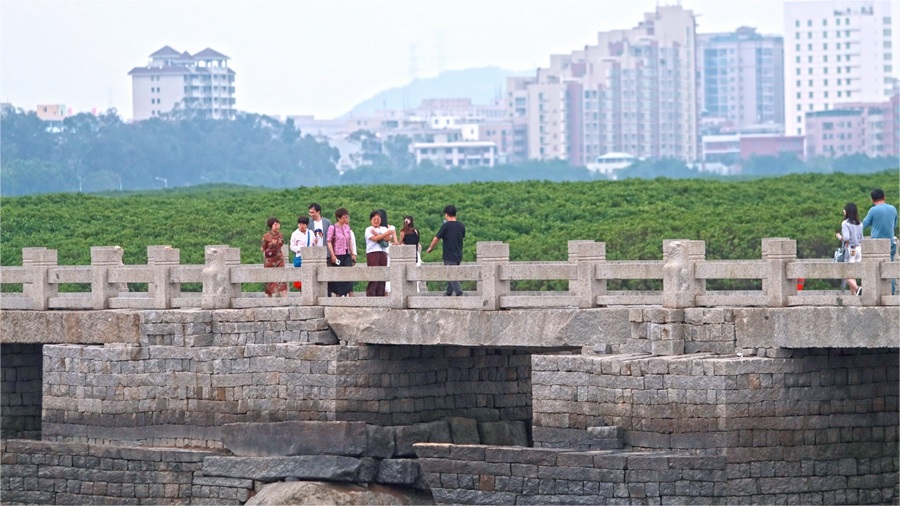"French farm to Chinese dining table" mechanism constantly deepens China-France agricultural cooperation

Sausages are packed in a workshop of French company Sacor. (Photo by Xing Xue/People's Daily)
According to China's General Administration of Customs, France is China's largest agricultural product import market and the second-largest agricultural product trading partner in the European Union.
By mid-2023, over 200 types of French agricultural and food products were allowed to be exported to China. Besides, nearly 7,000 French agricultural and food products companies have registered in China.
When French President Emmanuel Macron visited China in April 2023, Chinese President Xi Jinping conveyed to President Macron China's readiness to advance high-standard opening-up and share new opportunities in China's new development with countries around the world, and to work with France to build a "French farm to Chinese dining table" whole-chain rapid coordination mechanism.
Over the past year, the "French farm to Chinese dining table" mechanism has become a new highlight of agricultural cooperation between China and France. More and more French agricultural products are entering the Chinese market, providing Chinese consumers with high-quality and diversified choices, creating more opportunities to French companies, and bringing greater benefits to French farmers.
France is well-suited for the development of animal husbandry thanks to its climate. Statistics released by France's National Institute of Statistics and Economic Studies showed that the country's live cattle herd exceeds 17 million heads.
LACTINOV dairy group in France began direct export business in 2012, with the Chinese market as one of its main targets.
"More than a decade ago, I went to an international food exhibition in Shanghai to seek business opportunities," Alexandre Zeitlin, LACTINOV's export director, told People's Daily. "From the very beginning, we identified China as one of our most valuable target markets."
It is reported that as Chinese consumers' demand for high-quality dairy products grew rapidly, sales in the Chinese market accounted for 1/3 of the group's exports at its peak.
During Xi's meeting with then French President Francois Hollande in Beijing in April 2013, the two heads of state exchanged views on enhancing China-France exchanges and cooperation in a comprehensive manner, deciding to forge new areas of cooperation in modern agriculture, farm produce processing, and food processing.
In the next year, a Chinese delegation visited multiple French meat product companies, including Sacor, based in Aveyron, France, the first French company to export French-style dry-cured sausages to China. Soon, Sacor obtained approval to export its products to China, and its products officially entered the Chinese market in 2016.
"For a small family business like us, it's a milestone in our development to become one of the first companies to export to the Chinese market," said Nicolas Tournois, general manager of Sacor.
Over the years, he has devoted himself to understanding the Chinese market, actively participating in professional exhibitions, and continuously developing new clients.
"Our exports to China are currently in a stable upward trajectory," he said.
Today, the Bastides sausages of Sacor sold on Chinese e-commerce platforms are highly popular among Chinese consumers. Annual exports of the Bastides sausages to China have grown from 10 tons in 2019 to the current 60 tons, and they have frequently appeared at the China International Import Expo in recent years.
Tournois hopes that with the "French farm to Chinese dining table" whole-chain rapid coordination mechanism, more distinctive French agricultural products can enter the Chinese market.

Chief winemaker of the Bordeaux branch of Les Grands Chais de France tastes wine in a winery. (Photo by Xing Xue/People's Daily)
Bordeaux is an important wine-producing region in France and even globally. In a winery in Bordeaux owned by Les Grands Chais de France (GCF Group), a renowned French wine producer, red wine bottles come with QR codes that show various information, including the centuries-old history of the winery, the characteristics of the production area, the colors, aroma, and flavor of the wine, as well as recommended drinking temperature and food pairing suggestions.
"Chinese consumers have a much keener interest in wine culture than 10 years ago, so we intentionally designed the bottles this way," said Adrien de Vincenti, sales director of JIXIFU Caves & Domaines of GCF Group.
Adrien has been working and living in Shenzhen, south China's Guangdong province for over a decade and has a good understanding of the demands in China's red wine market.

French fragrance products are exhibited at the sixth China International Import Expo in Shanghai, November 7, 2023. (Photo by Weng Qiyu/People's Daily Online)
In today's Chinese market, wines from various regions of France can be found, covering many categories. "E-commerce platforms and social networks in China have made wine more mainstream, and wine appreciation courses have also accelerated the entry of wine culture into the lives of ordinary Chinese," he said.
During Macron's visit to China in April 2023, China and France issued a joint statement, in which the French side expressed its support for China's forthcoming application to join the International Organization of Vine and Wine, as well as its support for China hosting the International Conference on Grape and Wine Industries.
Adrien told People's Daily that in recent years, wine producing regions in several Chinese provinces and municipalities such as Shandong, Ningxia, and Xinjiang have become increasingly mature, and the development of China's domestic wine industry will promote the prosperity of the entire wine market.
Photos
Related Stories
- Leaders grow closer over places dear in memory
- Xi-Macron Pyrenees meeting adds momentum to relations
- Feature: French youths hail Village Super League, cultural exchanges with China
- Interview: French singer Joyce Jonathan makes waves on China's all-women reality show
- China extends visa exemption for 12 countries to 2025 year-end
- China signs 18 deals with France to expand economic cooperation, opening up wider for France, Europe
- Full text: China-France Joint Statement on the Situation in the Middle East
- Feature: "French farm to Chinese dining table" -- a culinary journey strengthening bonds across continents
- China, France to enhance global governance cooperation on artificial intelligence
- Feature: Xi, Macron exchange Olympic torches as gifts
Copyright © 2024 People's Daily Online. All Rights Reserved.









